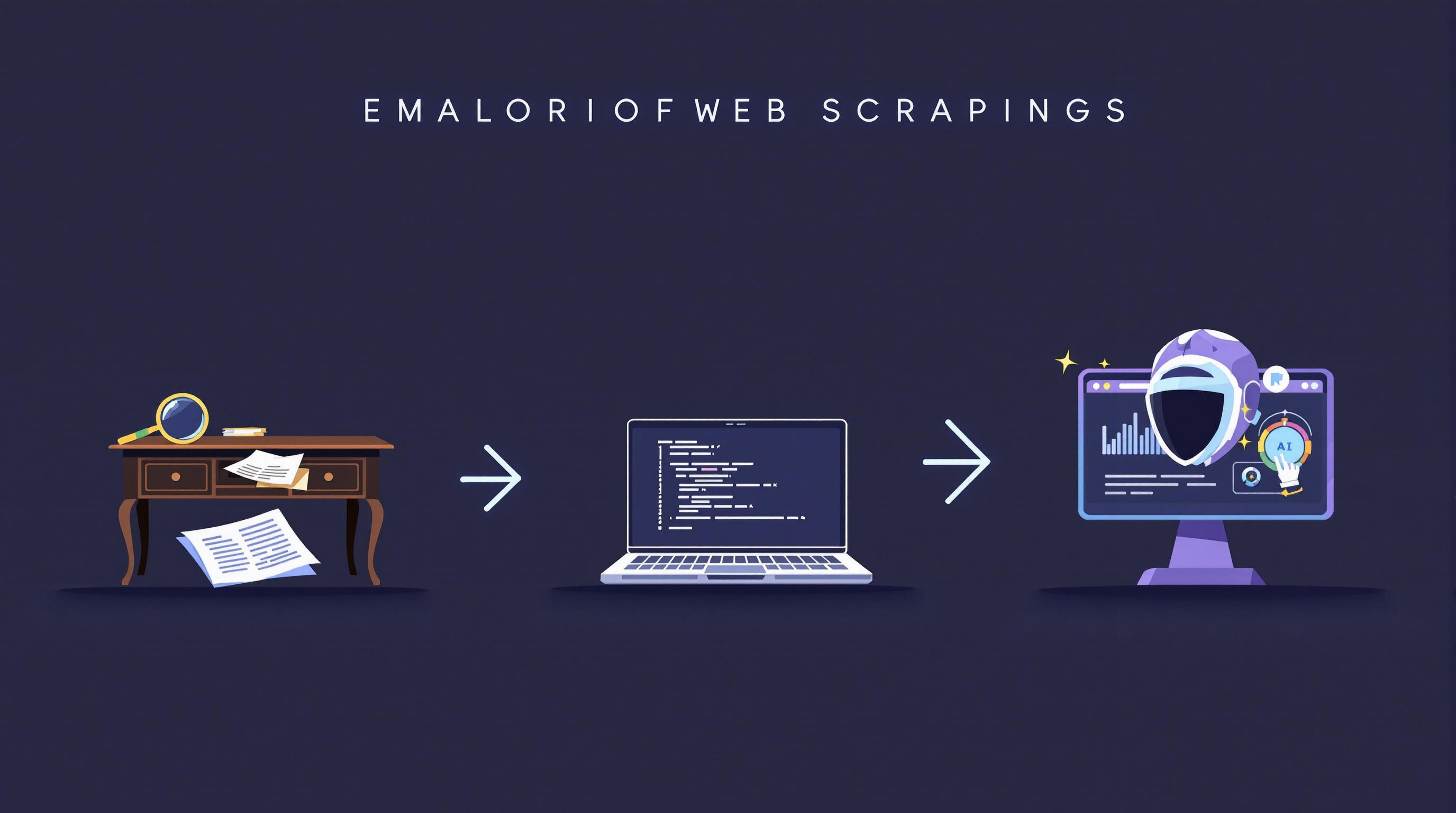Web scraping is powerful but risky. To stay secure and compliant, follow these key practices:
- Avoid IP Blocking: Use rotating proxies and randomize request patterns.
- Protect Data: Encrypt storage with AES-256 and anonymize sensitive information.
- Stay Legal: Follow GDPR, CCPA, and respect
robots.txtrules. - Mimic Human Behavior: Rotate User-Agent strings, adjust request timing, and avoid repetitive patterns.
- Regular Security Checks: Perform monthly vulnerability scans and keep tools updated.
Main Security Risks
Top Security Issues
Modern anti-scraping systems have stepped up their game, using tools like behavioral analysis and browser fingerprinting to detect and block unwanted activity with greater precision.
Data from ScraperAPI highlights that websites often rely on multi-layered defenses, including:
| Protection Layer | Detection Method | Impact on Scraping |
|---|---|---|
| Behavioral Analysis | Request pattern monitoring | Blocks suspicious access patterns |
| Rate Limiting | Request frequency tracking | Restricts excessive requests |
| Browser Fingerprinting | Identifies automated tools | Prevents automated access |
| CAPTCHA Systems | Human verification challenges | Prevents automated access |
These methods are increasingly common as websites aim to stop unauthorized data collection. Big players like Amazon and Walmart have rolled out highly advanced anti-bot measures to protect their platforms.
To combat potential breaches, organizations need to adopt strong encryption and secure data handling practices. But technical know-how alone isn’t enough - understanding the legal and ethical aspects is just as important.
Laws and Ethics
Web scraping professionals must navigate a complex web of regulations and ethical guidelines to operate within the law.
Here are some key legal frameworks and how they affect web scraping:
| Regulation | Requirement | Compliance Action |
|---|---|---|
| GDPR | Protection of personal data | Use data anonymization |
| CCPA | User consent and opt-out rights | Respect privacy preferences |
| ROBOTS.txt | Website access rules | Follow crawling directives |
| Terms of Service | Usage agreements | Adhere to platform terms |
"Web scraping is deemed to be a legal activity as long as it does not compromise the security of confidential information or the credibility and intellectual property of those whose data is collected." - HasData
Ethical practices are just as crucial as legal compliance. These include:
- Resource Impact: Avoid overloading servers by keeping request rates reasonable.
- Data Usage: Use collected data responsibly and disclose scraping activities when needed.
- Fair Competition: Steer clear of anti-competitive practices in data collection.
Staying compliant means regularly updating scraping methods to reflect new laws and ethical standards. This involves secure data handling, clear documentation, and a proactive approach to compliance.
Am I going to jail for web scraping?
Security Best Practices
Keeping your web scraping operations secure is essential for both safety and effectiveness.
Access Security Setup
Strong access management is the backbone of secure operations. Use a combination of API keys, OAuth 2.0, and JWT tokens to ensure only authorized users gain access.
| Security Layer | Implementation | Purpose |
|---|---|---|
| API Authentication | OAuth 2.0 + JWT | Provides token-based access |
| Data Encryption | TLS 1.3 / AES-256 | Secures data during transit |
| Access Control | Role-based permissions | Restricts user capabilities |
Once access controls are in place, focus on maintaining stable and undetectable connectivity with proper IP management.
Proxy and IP Protection
Managing IPs effectively helps you stay under the radar and maintain steady access to websites. For example, InstantAPI.ai's premium proxy setup uses rotating residential IPs to minimize block rates.
To boost proxy performance:
- Randomize request intervals: Use delays of 3-7 seconds to simulate human behavior.
- Monitor proxy metrics: Keep an eye on success rates and response times to ensure reliability.
Data Protection Methods
Safeguarding the data you collect and store is another critical aspect of secure scraping.
| Protection Layer | Method | Implementation |
|---|---|---|
| Storage Encryption | AES-256 | Encrypts saved data |
| Data Anonymization | Hashing/Masking | Removes sensitive details |
| Access Logging | Audit Trails | Tracks and logs data access |
Anti-Detection Techniques
To avoid detection, your scraping activities should mimic natural, human-like behavior. Here are some key methods:
- Browser Fingerprint Randomization: Change User-Agent strings, screen resolutions, and browser plugins to appear less predictable.
- Request Pattern Naturalization: Adjust request timing, simulate realistic navigation, and vary interaction sequences to avoid looking automated.
The goal is to behave like a real user, avoiding any patterns that might reveal automated activity.
sbb-itb-f2fbbd7
Long-term Security Management
In web scraping, managing security over the long term ensures your operations stay effective despite changes in detection systems and regulations.
Security Check Schedule
Regular checks are essential to spot and fix vulnerabilities in your scraping setup.
| Assessment Type | Frequency | Key Focus Areas |
|---|---|---|
| Vulnerability Scan | Monthly | Infrastructure vulnerabilities |
| Technical Security Reviews | Quarterly | Codebase and security controls |
| Compliance Audit | Annual | Regulatory requirements |
Use tools like OWASP ZAP or Burp Suite to perform vulnerability scans. These assessments are only useful when paired with prompt software updates to address any issues found.
Software Updates
Tools like pip or npm can help you track and apply updates for your scraping tools. Make sure to prioritize updates based on their urgency and automate patch management to streamline the process.
| Priority Level | Update Timeline | Example Scenarios |
|---|---|---|
| Critical | Within 24 hours | Zero-day vulnerabilities |
| High | Within 1 week | Security patches |
| Medium | Within 2 weeks | Feature updates |
| Low | Monthly | Minor improvements |
Even with regular updates, incidents can still happen. That’s why having a strong emergency response plan is crucial.
Emergency Response Steps
Use NIST's four-phase framework to handle emergencies effectively. This includes preparing by assigning roles, detecting issues with automated tools, containing threats quickly, and documenting incidents to improve future responses.
Key steps include:
- Isolating threats immediately
- Preserving evidence for analysis
- Restoring systems to normal operation
- Recovering lost or compromised data
Automated monitoring systems should be part of your protocol to catch unusual patterns, like unexpected proxy failures or strange data access behavior, and trigger alerts for quick action.
Summary
Main Points
Keeping web scraping secure requires a combination of technical safeguards and ethical practices. Key security measures include managing proxies effectively and protecting data at all stages.
Here’s a breakdown of the main components of data protection:
| Security Layer | Implementation | Impact |
|---|---|---|
| Request Authentication | HTTPS protocols, proper headers | Blocks unauthorized access |
| Traffic Management | Randomized intervals, request limits | Lowers risk of detection |
| Data Handling | Secure storage and transmission | Preserves data integrity |
| Compliance Controls | GDPR/CCPA adherence, robots.txt respect | Ensures legal compliance |
By focusing on these areas, you can build a strong foundation for secure web scraping.
Next Steps
To create and maintain a secure scraping setup, follow these steps:
-
Fine-tune request settings and monitoring:
- Set proper timeout values and retry logic.
- Track successes and failures to identify patterns that might trigger security systems.
-
Strengthen anti-detection tactics:
- Use tools like
httpbin.org/anythingto test and mimic real browser headers. - Randomize request patterns to avoid detection.
- Use tools like
-
Regularly assess your security:
- Stick to the vulnerability scanning schedule mentioned earlier.
- Keep a detailed record of security incidents for analysis.
Stay updated on emerging threats by following industry forums, technical blogs, and security advisories. This will help you adjust and improve your defense strategies as needed.
FAQs
How do you avoid IP blocking?
IP blocking happens when too many requests come from the same IP address in a short time. Using rotating proxy pools, like those provided by ScraperAPI, helps distribute requests across multiple IPs, making the traffic appear more natural and reducing the chances of detection.
Here are additional techniques to minimize IP blocking:
| Strategy | How It Works | Why It Helps |
|---|---|---|
| Request Timing | Add delays of 2-10 seconds between requests | Mimics human browsing behavior |
| User-Agent Rotation | Regularly change browser identifiers | Avoids detection of repeated patterns |
| Geographic Distribution | Use proxies from various locations | Makes traffic appear less suspicious |
To further protect your operations, combine these methods with well-structured request headers and proper authentication. These strategies, paired with strong security measures, help keep your scraping activities efficient and under the radar.


